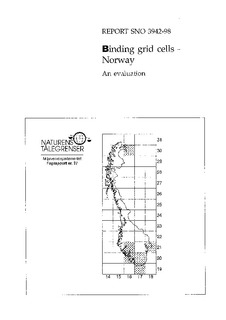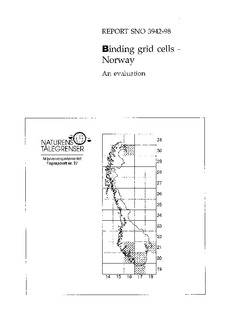| dc.contributor.author | Henriksen, A. | nb_NO |
| dc.contributor.other | Henriksen, A. - Project manager | nb_NO |
| dc.coverage.spatial | Norge | nb_NO |
| dc.date.accessioned | 2014-08-01T10:42:53Z | |
| dc.date.available | 2014-08-01T10:42:53Z | |
| dc.date.issued | 1998 | nb_NO |
| dc.identifier | 3942 | nb_NO |
| dc.identifier.isbn | 82-577-3533-7 | nb_NO |
| dc.identifier.issn | 1894-7948 | nb_NO |
| dc.identifier.uri | http://hdl.handle.net/11250/210140 | |
| dc.description.abstract | The quality of the critical load data for so-called "binding grid cells" in Norway has been checked. These are the following EMEP-grids (150km x 150 km): 16,20 16,21 16,30 17,19 17,20 and 18,21. Critical loads have been established for lakes in each 1o longitude by 0.5o latitude grid divided into 16 sub-grids ("NIVA grids", 12 km x 12 km). There are available data for forest soils in 720 grids and surface waters for 2305 grids. Surface waters are considered to be the most sensitive ecosystem in Norway, which is clearly indicated by the fact that for 93% of the grids with values for both ecosystems surface waters are more sensitive than forest soil. The soil critical loads do not influence the critical load percentile distributions significantly in the low range. The critical loads in Norwegian grids are well documented, especially in the most heavily affected areas in southern Norway and they compare well with the derived dose/response function for fish damage and critical load exceedance. For the "binding grid cells" there is additional lake data available to the number of "NIVA grids" in the EMEP-grid. The Birkenes grid (17,20) is the most critical grid. It covers the area of Norway most subjected to acidification, and where the earliest reliable records of fish kills and fish decline were recorded. Since this grid represents an area with the best documentation in Norway with respect fish damage and water chemistry (11% of the lakes analysed) we consider the critical load data for this grid to be the most reliable one in Norway. The lake percentiles for the binding grid cells are generally a little lower than those given by the database submitted to the CCE. This indicates that the lakes selected for the CCE-database slightly overestimate the critical load distribution in the grid. Thus, the critical loads are in fact lower than those reported to the CCE. There is therefore no justification for exclusion of any ecosystem data from the Norwegian critical load database. | nb_NO |
| dc.description.sponsorship | Miljøverndepartementet (MD) | nb_NO |
| dc.publisher | Norsk institutt for vannforskning | nb_NO |
| dc.relation.ispartofseries | NIVA-rapport;3942 | nb_NO |
| dc.rights | Navngivelse-IkkeKommersiell-DelPåSammeVilkår 3.0 Norge | nb_NO |
| dc.rights.uri | http://creativecommons.org/licenses/by-nc-sa/3.0/no/ | nb_NO |
| dc.subject | sur nedbør | nb_NO |
| dc.title | Binding grid cells - Norway An evaluation | nb_NO |
| dc.type | Research report | nb_NO |
| dc.rights.holder | Norsk institutt for vannforskning/Norwegian institute for water research | nb_NO |
| dc.subject.nsi | VDP::Matematikk og naturvitenskap: 400 | nb_NO |
| dc.source.pagenumber | 16 | nb_NO |
| dc.subject.keyword | sur nedbør | nb_NO |
| dc.subject.keyword | tålegrense | nb_NO |
| dc.subject.keyword | innsjøer | nb_NO |
| dc.subject.keyword | fiskeskader | nb_NO |
| dc.subject.keyword | acidic deposition | nb_NO |
| dc.subject.keyword | critical loads | nb_NO |
| dc.subject.keyword | lakes | nb_NO |
| dc.subject.keyword | fish | nb_NO |
| dc.subject.keyword | damages | nb_NO |
| dc.relation.project | O-89210 | nb_NO |


